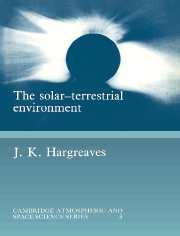 The Solar-Terrestrial Environment
The Solar-Terrestrial Environment Book contents
- Frontmatter
- Contents
- Preface
- 1 The Earth in space
- 2 The physics of geospace
- 3 Techniques for observing geospace
- 4 The neutral atmosphere
- 5 The solar wind and the magnetosphere
- 6 Principles of the ionosphere at middle and low latitudes
- 7 Ionospheric phenomena at middle and low latitudes
- 8 The ionosphere at high latitude
- 9 Magnetospheric waves
- 10 Technological application of geospace science
- Index
1 - The Earth in space
Published online by Cambridge University Press: 29 January 2010
- Frontmatter
- Contents
- Preface
- 1 The Earth in space
- 2 The physics of geospace
- 3 Techniques for observing geospace
- 4 The neutral atmosphere
- 5 The solar wind and the magnetosphere
- 6 Principles of the ionosphere at middle and low latitudes
- 7 Ionospheric phenomena at middle and low latitudes
- 8 The ionosphere at high latitude
- 9 Magnetospheric waves
- 10 Technological application of geospace science
- Index
Summary
Far out in the uncharted backwaters of the unfashionable end of the Western Spiral arm of the Galaxy lies a small unregarded yellow sun. Orbiting this at a distance of roughly ninety-two million miles is an utterly insignificant little blue green planet whose ape-descended life forms are so amazingly primitive that they still think digital watches are a pretty neat idea.
Douglas Adams, The Hitch-Hikers Guide to the Galaxy (1979)Introduction
The solar–terrestrial environment, nowadays sometimes called geospace, includes the upper part of the terrestrial atmosphere, the outer part of the geomagnetic field, and the solar emissions which affect them. It could be defined as that region of space closest to the planet Earth, a region close enough to affect human activities and to be studied from the Earth, but remote enough to be beyond everyday experience. Clearly, it is not the familiar atmosphere of meteorology; nor is it the inter-planetary space of astronomy, though it interacts with both. The material found there is mainly terrestrial in origin and strictly a part of the atmosphere of the Earth, though it is greatly affected by energy arriving from the Sun. Starting some 50–70 km above the Earth's surface and extending to distances measured in tens of Earth radii, geospace is a region of interactions and of boundaries: interactions between terrestrial matter and solar radiation, between solar and terrestrial magnetic fields, between magnetic fields and charged particles; and boundaries between solar and terrestrial matter, and between regions dominated by different patterns of flow.
- Type
- Chapter
- Information
- The Solar-Terrestrial EnvironmentAn Introduction to Geospace - the Science of the Terrestrial Upper Atmosphere, Ionosphere, and Magnetosphere, pp. 1 - 5Publisher: Cambridge University PressPrint publication year: 1992
- 2
- Cited by
